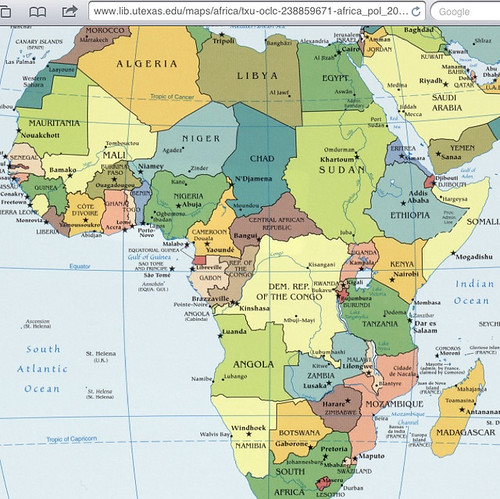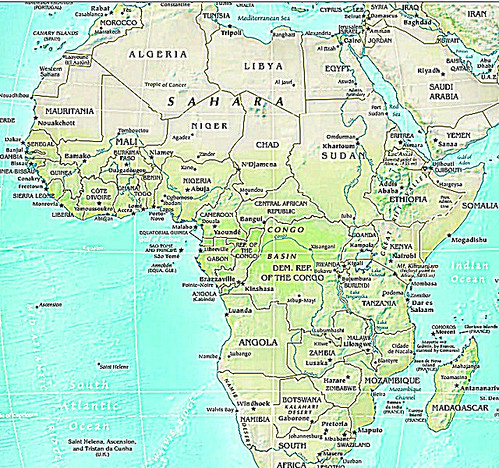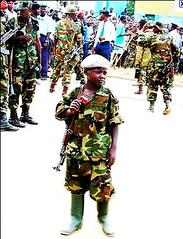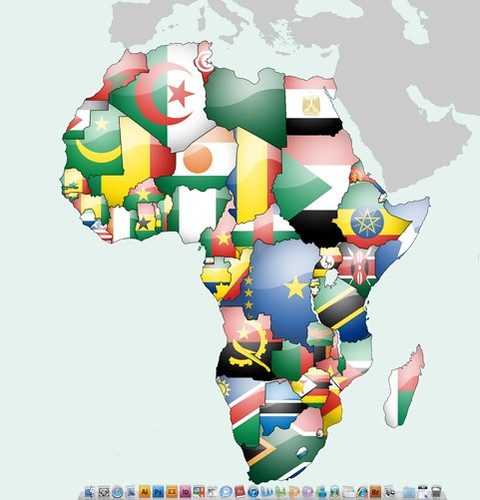Destination: DR Congo–sub-Sahara Africa
Status: post survival mode after the African World War (1993-2003) with continuing high crime rate
The first step
Before stepping off it is important to get a sense of why the DR Congo is so messed up. My theory is that the many victims of the Congo’s long and endless struggle are really victims of several problem causers: it’s geography; past colonization; greed for it’s great mineral wealth; and an overlay of psychopathy that looms in the jungles and rivers to creep into the minds of so many who live and die there.
The geographic problem causers
Africa is a stark contrast between deep, drippy green jungles and arid, scorched brown deserts. But the jungle and the desert on the surface cover a deeper and darker secret lying below: Africa is splitting apart. There is a continental split happening right through the heart of Africa–when you look at a map of Africa you can see Lake Victoria as a perfect symbol of the heart of Africa.The earth is doing to Africa the following: tearing a human apart by grabbing each rib cage and splitting the sternum in half. No wonder Africa has such deep problems. But that is just the nasty underlying start to the problems.That rift, which runs along the eastern border of the Congo, has produced a mountain range with still active volcanoes. Thus, there is an isolating barrier to the east. Then, the rivers and swamps throughout the central part of the Congo make an effective barrier to the west of the Congo’s eastern provinces. In essence, the eastern provinces are isolated. Ask any criminal what is the “best” way to victimize a person or people and the bet is on that the criminal will say his strategy is to first isolate them. The geography surrounding the eastern provinces has done that. Thus, the people there have been left to be preyed upon by rebel groups, foreign (neighbouring) countries, business interests (especially mining companies), and even their own government. Even the UN has struggled in it’s efforts to help the people there. But as General (now Senator) Dallaire recently said (rhetorically) about the situation: “How many times can Humanity fail before we give up on it?”
How the European colony concept just did not work
In short, colonization did work for the Europeans, but not for the people of Africa. At best the indigenous people were resources and at worst the victims of tyranny. There was a lot of political pushing and shoving going on in the 1800s: but in the end the main players were the French and English, with guest appearances of note by the Germans and Italians. (The Spanish and Portugese were busy in South and Central America.) The map below shows the French (in green) dominated western Africa, and the English (in red) controlled much of the east, with the goal being a north/south corridor from Egypt to South Africa. There were various battles, skirmishes and conflicts of all kinds: tribe to tribe, tribe to colonist and colonist to colonist. The most notorious is probably the Boer War, which showed that even at the end of the 1800s, the colonists had not learned how to work things out peacefully. The map we see is from the early 1900s and really represents how Africa was sliced up by agreement amongst the Europeans in the 1880s. You will note there is one blotch of orange on the map: the Belgian Congo. That one bit of Belgian colonization was the result of some crafty politicking by King Leopold of Belgium, who aggressively wanted some of the action in ivory and rubber. He got it by playing off the various power struggles both in Europe and in Africa between the French, English and Germans. Their thinking, I guess, was better to give the Congo to a non-rival. Thus, good King Leopold had indeed a kingdom onto himself. And, apparently, no one kept track of his behavior. Reports are that those not meeting their (imposed) quotas for ivory or rubber production lost a hand, an arm, or a family member (who were held hostage to ensure production).The point is that the people of the Congo have never had a break. Once colonization started breaking apart across Africa in the 1960s, some countries fared better than others, depending which despot took control. Sadly, you may have guessed, the once Belgian Congo became Zaire under a tyrant who ruled for about thirty years. His reign had been called a “kleptocracy” because of the huge resources taken for his own benefit. His reign literally came to a dead end in the 1990s, only to be followed by the African World War in the Congo. That takes us into the 21st century, with the lingering problems of colonization continuing: exploitation, corruption and crime. There is hope in the form of an elected government (hence DR Congo) and a huge UN presence. But these latest efforts sit atop a large mass of brutality. We’ll see how the justifiably skeptical people of the Congo fare under this latest regime.
Current greed for the Congo’s great mineral wealth
It appears that lots of bastards want a bite out of the rich mineral pie that is the Congo. The notorious Hutus (remember the 1994 slaughter of Tutsis) have pushed their operations out of Rwanda into the Congo and continue to cause grief. Rebel groups from Uganda have done the same. Then there was the decade long conflict in the Congo called The African World War (“ending” in 2003) which generated millions of deaths. “Neighbors” such as Angola and Zimbabwe jumped into that bit of fighting–and left, I suspect, with something more in their pockets than empty shell casings.
Even peace keeping troops sponsored by the United Nations have dipped into the pie: some soldiers from Bangladesh recently got nicked for trading munitions and food for gold and diamonds. The Congo has the world’s largest UN force–some 18,000 strong.
In fact, this computer and the one you’re reading may contain elements smuggled illegally from the Congo. Turns out there’s a lot of a rare mineral called Coltan in the Congo. Coltan contains Niobium and Tantalum, two elements essential to make the electronic capacitors inside our new high-tech world–cell phones, televisions and all those other great devices through which we see news reports about people dying because they have no water or food.
We are still talking about Tantalum here. With a great market pull, Coltan makes it’s way out through neighboring countries and into the hands of manufacturers such as the Chinese.
An ironic, sad commentary about Tantalum is this: I suspect Tantalum is named after the greek myth of Tantalus. He decided to anger the Greek gods by having too big an ego (“hubris” in the Greek world– do not equate yourself with the gods). So the gods decided to punish him by having him spend eternity with his body in water up to his neck. But he could not get a drink of water. And there was fruit and food–but just out of his reach. So Tantalus spent his time (and perhaps he still does) just out of reach of everything. That is relevant to the Congo.
Tantalum is apparently in great abundance in the Congo, but is being smuggled out. Thus, the people of the Congo do not get any benefit from it. Just like Tantalus, the people of the Congo watch and wait, but do not have the chance to benefit from the great resources just in front of them.
For a terrific summary of the situation, access photographer Marcus Bleasdale’s short video:http://magazine.viiphoto.com/feature/show/43
Add a psychotic overlay from years of conflict
Pick a psychosis, any psychosis and sadly you will find it alive and living in the eastern Congo.Maybe we can start at the top and work down. Africa, from the colonial period, through the post-colonial period, to the present has generated a series of tyrants in control who were choice examples of megalomania and narcissism. King Leopold fit the bill as did Idi Amin in Uganda–a charicature of the concept if he had not been so real and deadly. My pop psychology research says that Megalomania is a symptom of a manic or paranoid disorder. And Narcissism arises from a failure to distinguish the self from external objects and is a feature of a mental disorder. Enough of that, except to say when there is serious psychosis at the top, then it can’t help but be forced onto the people below. For example, victims of violence do themselves later become the victimizers. Of course, that is not always the case, but is one explanation of the terrible cycle of violence that plagues the eastern Congo. Psychosis often is the result of brutal childhood experiences, and can we think of any worse than being a multiple victim of violent crime or being forced to be a child soldier and do abhorrent violence because forced to?Then around, inside, and on top of a long, personal history of violence there is a group psychosis each person must face, whether due to tribal pressures, or because of pressure from rebel groups. My point is that there are many and longstanding sources of violence that come from within the people themselves–and many times they really do not have any say in the matter. Hence the violence continues. Just to pull a thought from a different country–Cambodia. After the Khmer Rouge were pushed out by the Vietnamese, the UN stepped in and offered democratic elections. But after the atrocities suffered by the people, counseling was what they really needed. It seems the international community has a limited tool kit when moving into areas where atrocious crimes have been the norm. Even so, some stability in the form of law enforcement is still better than ignoring the place altogether. From stability may come less fear, and from there hope may start to creep in, then with that comes the chance to change that nasty undertow, which is the psychosis caused by so much violence.
The Conclusion for Now
Put geography, colonization, greed and psychosis all together and you find the DR Congo– right in the heart of Africa and one of it’s worst places to be.
But let’s take a moment to set some context to the rest of Africa. As you will have heard in recent news reports, thousands of refugees are fleeing Somalia and arriving at refugee camps in Kenya. Now, with more than 400,000 in the camp at Dadaab, it rates as the world’s largest. Thus, in the Congo, the UN has it’s largest contingent of troops. And just next door to the east, the UN has it’s largest refugee camp. Perhaps ironically (and no doubt sadly) a virtually pristine Lake Tanganyika forms the border between the Congo and Tanzania, and–get this–contains one-fifth of the world ‘s fresh water. Yet less than a 1,000 miles to the northeast drought and famine are killing thousands in Somalia. Africa is full of contrasts and contradictions that defy logic, reason and even sanity. And to put a context to the violence, the Economist recently reported that South Africa has “around 50 murders, 100 rapes, nearly 400 armed burglaries and over 500 violent assaults recorded every day.” I say again–“every day.”Maybe we should stop ignoring this place.
So Why Go?
What the heck else was I going to do? I had been training for a few years to do an overseas mission, but I had thought it would be Afghanistan. The Congo job was handed to me on a platter, in the form of an interoffice email.Like most people in North America, I knew little about the intense slaughter that has gone on there for so many years. And the more I learn, the more I realize it’s a real choice mission. The parallels to Heart of Darkness and Apocalypse Now have not been lost on me, since the original story is indeed a trip up the Congo River to find Kurtz. The movie used that as it’s story line, and in both the trip up the river symbolizes the journey into someone’s mind. Only I won’t get the trip up the river to have time to figure things out.It will be a week in Kinshasa for training, then out somewhere into the eastern provinces to work with a team hunting for our own various Kurtzes. For sure there’s one real life Kurtz, who is more menacing and nasty that both the book Kurtz and the movie Kurtz put together. His name is Joseph Kony and he leads a brutal rebel group called the Lord’s Resistance Army (LRA).For more than two decades they have been terrorizing and brutalizing their way in the region of the northern Congo, Uganda, south Sudan, and Central African Republic.This week President Obama said he is sending 100 armed military advisors into that area to take a shot at Kony and the LRA. Seems Africa is great at producing crack pot despots and demonic rebels. But that leaves the people themselves isolated and vulnerable to the whims of such people. That is when the international community has to do something. Hence these efforts to prosecute some of the worst of the worst. It may not be much in the face of so much for so long, but a start is a start is a start. Maybe with some effort and some time, some of the people will be able to live day to day with less and less fear. And when fear is not part of their daily diet, then maybe hope and happiness will have a chance to grow.And there are stories of hope and success. Look up Emmanuel Jal. I saw him give a dynamic music performance this summer in Vancouver. After a couple of songs, he paused to dedicate the next song to a woman who had saved a large number of child soldiers, then he said “I know, because I was one of them.” Click here: Emmanuel JalI have been told to bring my sense of humor, but to leave my sense of smell. As our friend Leonard Cohen said “the secret to enlightenment is to lighten up.”On a last and literal note of optimism about Africa, check out the YouTube performance of the song Africa by the group Perpetuum Jazzile.And with that I will sign off for now. More reports when I can.
This map is a wonderful symbol of the potential within Africa
Saskatchewan Story (About Hope)This painting of a surviving deer has carried me through many miles of tough travel. For many, many years when I have been in tough situations the “little deer” has jumped into my mind to remind me that we can survive.Little deer is from Saskatchewan and in the painting we see that she has just survived a tough Canadian winter.The snow that she is standing in is clearly spring snow: It has that melted look that only comes in the springtime.Many times I have walked through that beautiful crunchy, wet snow while thinking NOW there is change afoot. But little deer stands there with her ribs stretched as far as they can go and clearly this is the first winter she has been through. So what could be her thoughts? That little deer sends out a message of hope and love and hope and love. Because she has lived through a Saskatchewan winter and knows not that spring brings a repetition of the seasons. Little deer only knows that she is suffering less because of the cold. She looks up in hope because somehow the snow under her feet is not so deep, is not so cold. There is hope for reasons she cannot say.






